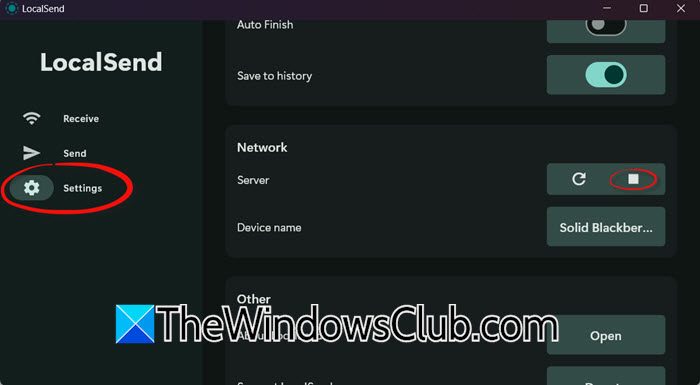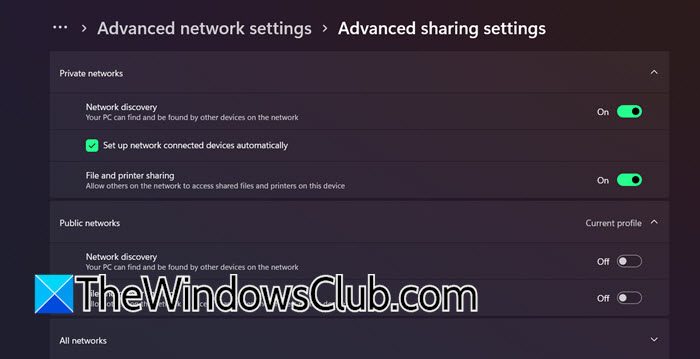If LocalSend is not working or unable to find devices on your PC, you are not alone. This can be frustrating, especially when some files need to be transferred immediately. In this guide, we will explore the common reasons behind the error, and provide practical solutions that you can perform if the LocalSend is not working or finding devices.
Why is my PC not detecting my device?
The PC may not be able to detect devices due to various reasons such as network issues, AP isolation, or VPN interferences. Moreover, it is also necessary to ensure both devices are on the same Wi-Fi network and that LocalSend is allowed through a Firewall. In the next section, we are going to explore these reasons in detail.
LocalSend not working or finding device on Windows PC
If LocalSend is not working or showing no available devices on a Windows PC, check out the solutions mentioned below:
- Restart the LocalSend server
- Ensure that both devices are on the same wi-fi network
- Disabled AP isolation on the router
- Turn off the VPN
- Ensure Device Discovery is enabled
- Share the Files via Link option
Let’s get started with the troubleshooting guide.
1] Restart the LocalSend server

The service may encounter glitches, fail to broadcast its presence, or get stuck due to network issues. In such situations, it is recommended to restart the LocalSend Server to reinitialize the connection and clear temporary glitches.
- Launch the LocalSend app, and click on the Settings options from the left bar.
- Scroll down to find the Network section, and click the square black button in front of the Server option.
- Wait a few seconds, then press the Play button to restart the server.
Follow the same procedure on the other device, and see if the devices are visible now. If not see the next solution.
2] Ensure that both devices are on the same Wi-Fi network
LocalSend relies on local network discovery to detect nearby devices, which is only possible if both devices share the same Wi-Fi network. If they are on different networks such as mobile hotspots or separate routers, they cannot communicate, and hence we see the device not available error on the screen. Verify whether this was the factor causing the issue or not. If not, move to the next solution.
3] Disabled AP isolation on the router

AP Isolation (Access Point Isolation) prevents devices connected to the same Wi-Fi network from communicating with each other. Since LocalSend relies on the local network, transfer between files is not possible. Therefore, we are going to disable AP Isolation, and here’s how to do it.
- Log in to the router’s admin panel by launching a browser, typing the IP address, and entering the credentials.
- Navigate to Wireless/ Advanced/ Security settings, and then look for any of these terms- AP Isolation, Client Isolation, or Wireless Isolation.
- If it is enabled, disable it, and restart the router to save the changes.
Reconnect all devices and test LocalSend again.
4] Turn off the VPN and firewall
VPN and Firewall can also be contributing factors since the former routes traffic through external servers, and the latter restricts ports and traffic, hence restricting the app’s communication. In this case, we recommend disabling VPN by going to Settings> Network and Internet> selecting the VPN, and clicking the Disable or Remove button. Moreover, follow the steps mentioned below to temporarily disable the firewall.
- Click Win + R to open the Run dialog box, type firewall.cpl, and click OK.
- Click on the Turn Windows Defender On or Off option from the left panel, and tick the Turn off Windows Defender box in both the Private and Public network settings section.
- Click OK and restart the app.
Now, see if the devices are visible, and if yes, try to send a file. If it works, re-enable the Firewall, and manually allow LocalSend through Windows Defender Firewall.
5] Ensure Device Discovery is enabled

If Device discovery is disabled, Windows PC won’t recognize or communicate with other devices. Hence, it must be enabled to ensure that LocalSend can broadcast and receive signals properly.
- Click Win + I to open Settings. Then click on Network and internet and Advanced network settings.
- Click on Advanced Sharing Settings, and expand the Private Networks section.
- Toggle on the Network Discovery, and File and Printer Sharing buttons.
Hopefully, this will resolve the issue, if not see the next solutions.
Read: Bluetooth file transfer not completed, File transfer is disabled by policy
6] Share the files via link option
Last but not least, if LocalSend is still not detecting devices or facing connectivity issues, the Share via Link option is an alternative way to transfer files. This method generates a direct link that receivers can open in a web browser to download the file.
- Launch LocalSend, go to Settings, and click on the Send tab.
- Navigate to the Nearby Devices section, tap the Setting button, and select the Share via link option.
- Several links will appear on the screen, copy them or create a QR code for it, and open it up on another device.
That’s it.
Read: Share files between Mobile and PC using Phone Link in Windows 11
How do I enable Find My Device in Windows 11?
To enable Find My Device in Windows 11, click Win + I to open Settings, go to Privacy and Security, and click on Find My Device. Toggle Find My Device to ON. You must be signed into your Microsoft account and have the location service enabled.
Leave a Reply